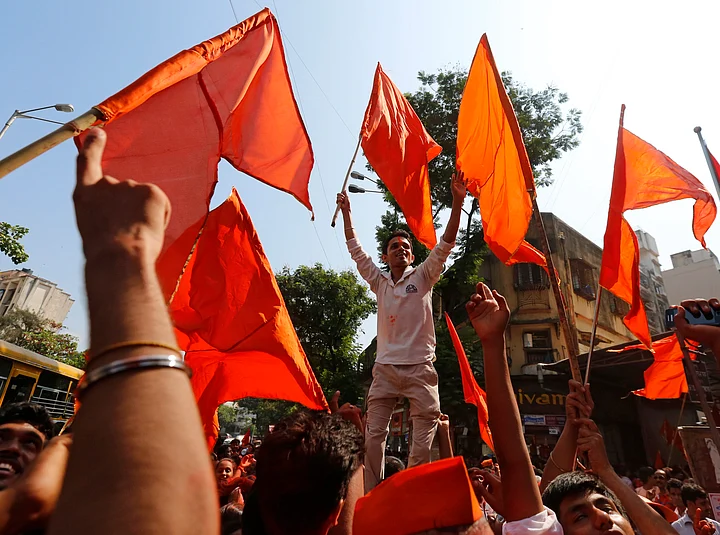It is difficult to imagine Maharashtra’s politics of the last 52 years without the Shiv Sena and the Thackarays who remained at the centre of the political evolution of the state. By their aggressive identity politics and by their violent campaigns, by their notoriety and also their opportunist flexibility, the Sena managed to draw national attention despite the fact that it was in power only for just one term of less than five years. This means they were out of power for 44 years.
The Congress or the Congress-led Progressive Front ruled the state for most part since 1960, the year when Maharashtra was carved out on the linguistic basis. In one fell stroke, three states emerged: Maharashtra, Gujarat and Karnataka. The contentious issue was what should be the status of Bombay. (Bombay became Mumbai in the mid-Nineties after the Sena-BJP alliance came to power). The business community, wanted the city to remain bilingual, and some argued for Mumbai to be declared a Union Territory, on the lines of Delhi or Chandigarh. But the Samyukta Maharashtra Movement, led by the communists and socialists, wanted Bombay to be Maharashtra’s exclusive capital.
The movement often took violent turns and Marathi militancy was directed against the “capitalist” Gujarati and Marwari business communities. The proletariat class was predominantly Marathi and at the vanguard of the national trade union movement. Balasaheb’s father, Keshav, widely known as “Prabodhankar” (named after the social reformist periodical, titled “Prabodhan”) was one of the leaders of the Samyukta Maharashtra Andolan. Though directed against the Congress, the movement petered out once the state was born. Under Jawaharlal Nehru’s leadership, congress reestablished its hegemony and came to power in 1962.
Shiv Sena was born in 1966, four years after the state came into existence. The idea of creating such an outfit was that of Balasaheb’s fathers. As a leader of the Maharashtra movement, he said that the Congress did not have its heart in Mumbai and its Marathi character. To keep that identity, the people of Mumbai would have to remain vigilant. Otherwise they would get marginalised in the name of cosmopolitan liberalism.
That apprehension was soon to become paranoia. Out of that paranoia and in the worsening economic situation in the Sixties, the Shiv Sena took shape, almost literally on the streets. A whole new generation had come of age after independence. Industrial growth and economic upswing of the Fifties had come to a halt. The two wars, with China in 1962 and with Pakistan in 1965, had taken its economic toll. There were no jobs and the army of the unemployed had started roaming streets. It was natural that the discontent spread among the Marathi youth. Bal Thackreay (he became Balasaheb much later) edited a Marathi cartoon weekly, Marmik, which began to highlight the grievances of Bombay’s Marathi community.
Through the weekly an appeal was issued that it was time to start the “remaining” Maharashtra movement again. The Marathi youth must come forward to dedicate their life for the Marathi cause – jobs, language, culture and identity. The original “enemy”, the capitalist Gujarati-Marwari was replaced by the “Madrasi” (all South Indians were identified as such and derogatorily described as “lungiwalas” who were supposedly “stealing” Marathi jobs).
Soon, the Udipi chain of hotels and South Indians in white collar jobs were physically attacked. The Sena changed its goal post two years later and began targeting the Leftist trade unions. Unless the Leftist control over the trade union movement was removed, the city and its working class would not come under the Sena command, said Balasaheb.
This campaign included forming parallel unions to organise strike breaking activities. The mobilisation of black legs led to the creation of a new mafia in the metropolis’ underbelly. The murder of comrade and MLA Krishna Desai in 1970 spread the tentacles of terror. The Sena acquired the image of a reckless violent mob, since that day. From trade union leaders to littérateurs, from social workers to media persons and from ghazal maestro Ghulam Ali to M F Hussein all came under the Sena’s terror clouds.
The Sena also had a parallel network of social workers and do-gooders who organised sports competitions, blood donation camps, folk art sammelans, Ganesh and Shiv Jayanti festivals and so on. Through these activities the Sena built grassroots community activists. These social events were funded, protected and promoted by the same elements which also used to spread fear psychosis.
No other party in Maharashtra has been able to create a vertical and horizontal structure incorporating do-gooders and criminal elements, genuine mass contact local leaders to ambitious political leaders, hi-octane demagogy to communal and identitarian rhetoric. Even after Balasaheb’s death nearly three years ago, this structure has survived. Uddhav is at the helm, but this diverse outfit continues, though weakened, to hold people in awe and fear.
(The author is a senior journalist and media consultant.)
(The Quint is republishing this story. It was originally published on 19 June 2015.)
